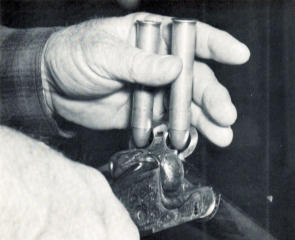| DUGABOY1 |
| (.400 member) |
| 09/09/07 09:23 AM |

|
|
|
Quote:
Thanks for the quick response.
I assume that regulation of the O/U rifles is much easier to accomplish than with the SxS variety. Does that also mean that O/U rifles are less affected by load changes?
Trey The regulation difficulty is not a worry to you, as the owner, because that is done at the factory!

The using of the word REGULATING , interchangeably with working up loads for a double rifle, is where the great bulk of misunderstanding of how double rifles work comes from!
The regulating of a double rifle is a physical process of building the barrels sets with the proper convergence so that the rifle shoots properly. The fact that the barrels physically converge is taken by many to mean that the bullet paths converge also, and they do not! The properly loaded side by side, or Over Under double rifle the centers of each barrel’s individual group remain parallel down range, and the center of each barrel’s group do not cross if the load is right. The misconception that they do cross at a given point is incorrect. This misconception comes from the knowledge that the barrels physically converge, and the writers who write for the gun rags who mistakenly believer this because the adds for the rifles state that the rifle is regulated AT 100 MTRS, or 50 MTRS, an they take that to mean the bullets cross at that distance. This is also, incorrect! What the distance stated means that is the distance the STANDING iron sight is cut (REGULATED) for, for elevation, and windage for the center of a composite group of both barrels. The rifle may have several flip-up sights for longer ranges, yet the centerline of these sights are all in line with each other. If the bullets crossed at 100mtrs, how would these sights line up to 200, and 300 mtrs. Many writers assume these flip-ups are strictly for decoration, and are useless. If the load is proper, these sights will be dead on at the ranges engraved on them.
The difference between the O/U, and the S/S double rifles where regulation is concerned, is simply that the recoil arc is different, but the loads still must place the hits on the target parallel. The top barrel above the bottom barrel, and in line for windage, for the O/U. With the S/S, the barrels must print the barrels side by side at the same elevation. The barrels are still sensitive to bullet weight, shape, and speed, no matter the configuration! If the load is too slow, it will shoot apart, and high, if it is too fast they will cross, and shoot low this is true of both types!
